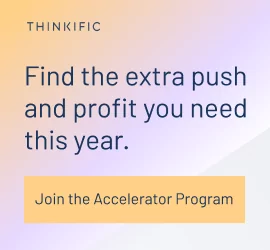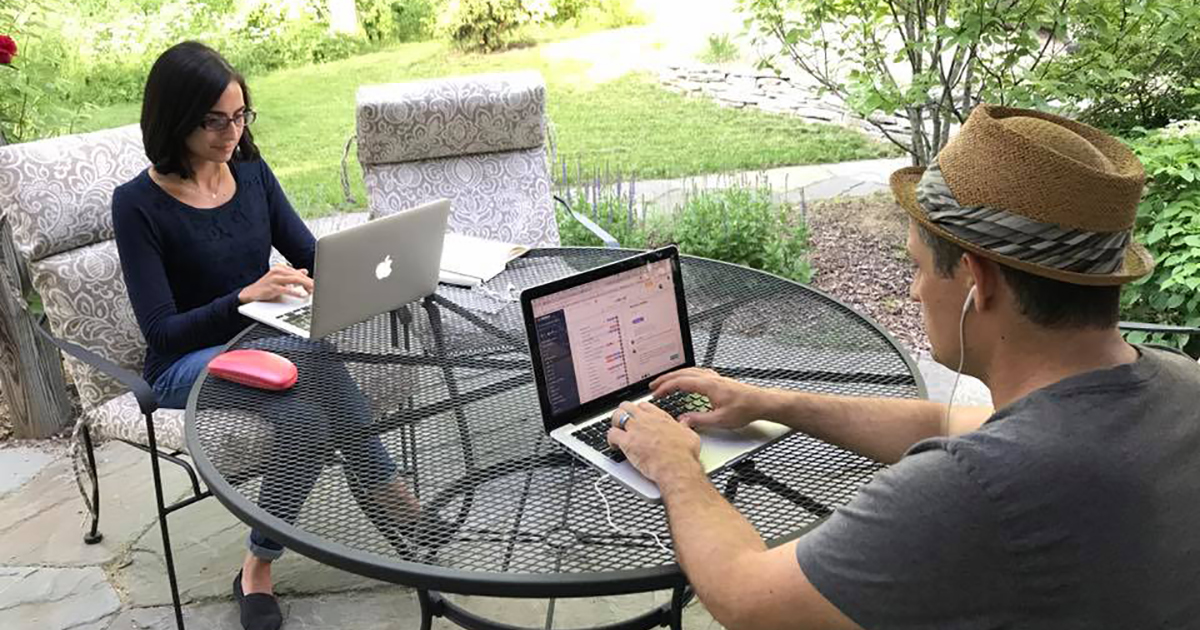As an author, you are an expert on your topic.
But building your content into an online course is a whole new undertaking.
How do you know what content to put in your course, and make sure it will sell?
Get it right, and you’ll be creating a new revenue stream to add on top of your book sales.
Get it wrong however, and you’ll have wasted a lot of time and effort.
Hear from course creation expert Danny Iny on his method to creating profitable online courses:
Why Authors Should Create An Online Course
There are a few reasons why authors and online courses go hand in hand.
The first is the difference between books and courses. They serve very different purposes.
Books are good for transferring knowledge, but they are not good for developing competency.
Online courses on the other hand, are designed to help people develop real competence and expertise.
In other words, books are great at teaching the WHAT, and online courses are great at teaching the HOW.
Another reason why authors should create online courses is that your income will be limited if all you do is sell books – purely because of the price point.
Instead of selling books, Danny recommends giving them away in exchange for the opportunity to start a dialogue with your target audience, with the eventuality of leading them to your online course, which you can sell at a much higher ticket price.
You might be resistant to the idea of giving away your book for free – you have worked hard at it after all. But as Danny mentions:
“For every person who wants your book enough to buy it, there are probably 20 people who would download it for free.”
– Danny Iny
As an example of the difference in potential revenue, Danny sold about twelve thousand dollars in books sales in 2012, which is an impressive figure on its own.
But then following up his strategy, he made another quarter of a million dollars selling courses to the people who then downloaded the book for free.
How To Identify The Right Topic For Your Online Course
When it comes to choosing the right topic for online courses, many authors tend to get it wrong.
With the highly creative, intelligent minds that they have, it’s difficult for them to narrow down exactly what they want to teach. And often as a result, they try to teach everything they know.
But this only serves to overwhelm your audience.
To really narrow down and identify the one topic to cover when creating your own online course, you must begin with the end in mind.
Ask yourself, “What is the outcome that I want this course to deliver?”
Think about the outcome of a customer at the end of your course:
- What do you want them to know?
- What do you want them to remember?
- What do you want them to feel?
- What do you want them to be able to do?
By doing so, you’ll find yourself with much clearer focus and vision.
But how do you know whether the outcome you choose is the right outcome for your audience?
According to Danny Iny, the best way is to leverage a psychological bias we have as people called the IKEA effect.
Essentially, it’s where people value things they played a part in creating more than if they didn’t – even if what they created wasn’t as great as something they could’ve just bought off the shelf.
And as Danny suggests, you can make use of this effect by asking your target audience to help you create an online course that they want during the pre-sales process.
Not sure how to ask your audience to help you create an online course?
Watch the video above to hear exactly how Danny words his compelling offer.
By doing so, you can guarantee that you’ll actually be able to sell your online course instead of spending so much time and effort building a course that people ultimately aren’t looking for.
How To Create An Online Course: Best Practices
It’s very tempting to want to just create an online course, then set it and forget it.
Because then you’re minimally involved.
But as Danny points out, the mindset between running your first online course, and the way you ultimately build your online course to scale is completely different.
Because in order to make sure your ultimate online course is of the highest quality, your pilot (i.e. the first version of your course) needs to be live.
In other words, the first version of your online course could just be you teaching live via video, from a high-level perspective.
Why?
One reason – You’re able to interact with your students, answer their questions (including the ones you haven’t thought about), and get feedback on how to tweak your online course.
By doing this, you can then use recordings of your live pilot to create and sell your full online course with much more quality and assurance.
Tools To Use In Creating An Online Course
The great thing about your pilot course is it doesn’t have to be high-tech.
As Danny Iny mentions, “You don’t need to add technological challenges that don’t need to be there.”
What he recommends as a great tool to start with is Zoom – the very same platform our conversation with Danny was recorded with.
Once you’ve gotten to the point where you’re ready to take on the next step and create a higher quality production, you can make use of online course creation software like Thinkific.
Now, if you’re concerned about creating low-tech pilot courses and whether it’s good enough to sell, that’s totally okay. It’s a very common concern. As Danny points out, it all comes down to positioning.
Yes, your first iteration of your online course is going to be a little rough around the edges in terms of production quality.
But if you frame it right, your customers can actually value it more.
Think about it.
By taking part in your pilot course, your customers:
- Get access to a world-class author (that’s you!) that they wouldn’t otherwise get
- Get to be part of the creation process of the ultimate course you’ll release (the IKEA effect)
That’s something that they simply won’t be able to get when you’ve created the best online course you can.
And as such, it’s highly valuable – potentially even more so than later iterations of your product.
How To Price Your Online Course
Recording a pilot for your online course is simple. But at the same time, it can feel overwhelming. Especially when you have constant back-and-forth questions in your mind about pricing like:
- How am I going to price this?
- What if they don’t think it’s worth as much as I know it is?
Part of what you want to do with testing your pilot online course is to validate that people will pay what you think your course is worth.
In other words, you want to make sure that the value they’re getting out of your course is exactly the value they’re looking for. That way, there shouldn’t be a question on price versus value.
How To Refine Your Online Course During Your Pilot
The main thing to look out for is the questions you get asked as you run your pilot. There are typically two types of questions:
- Questions where everyone is asking the same thing – these are easily answered. All you need to do is address these in your online course.
- Questions that are unique to the individual – these require more support from a human perspective.
The goal is to iron out all the ‘what if’ questions your target market has so that in later iterations of your product, you can hire other people to answer those unique questions and start to step away from being too involved in the content delivery process.
What Type Of Content Should You Use To Deliver Your Online Course?
As Danny mentions, “all things being equal, we’re visual people and we like to watch video. But not everybody prefers to watch video.”
As such, you want to use the same medium that your target audience likes – If you know your audience is mainly writers, then chances are they like to read.
Danny is also a firm believer in not using richer media than necessary to deliver content.
For example, if you have an audio lesson – that’s something you can listen to and learn from while you’re out for a walk. But if you have a video lesson, your audience will have to sit somewhere to really take it in.
So if you have content that requires diagrams and models to explain what’s going on – then use video. But if your video is simply you speaking to the screen, then it’s probably a better idea to just use audio.
According to Danny, there are two types of content you can create for people:
- Intentional content – this is content that students have to sit down to absorb and really take in. Think TV shows that you’ll only watch when you’re on the couch with your spouse with no distractions.
- Interstitial content – this is content that’s easy to consume, that you can easily take in at 5-10 minutes at a time. Think about content you like to read and engage with.
The key to an effective online course is to design your curriculum in a way that balances these two elements.
Ask yourself:
- What are the components of my course that really require my audience to be present and focused?
- What are the components of my course that could be consumed on a more interstitial basis?
As an example, you might have a section of your course that is audio-only. And other parts that require your students to sit down and watch a video of you explaining concepts with diagrams.
Why Some Online Courses Fail And Why Some Don’t
According to Danny, the number one reason why online courses fail to sell is because of misalignment between what the market wants and what the course offers.
To add to that, the biggest reason any product fails according to Danny is “hubris on the part of the marketer or course creator thinking that they get to decide what other people should want.”
That’s why doing pre-sales is so important. You can’t tell people what they want. You can only give them what they already want.
All marketing comes down to two simple steps:
- Lead generation – you need people to discover you
- Conversion – you need to be able to sell to people who discover you
The common mistake that most unsuccessful course creators make is that they try to go for too many lead sources and conversion mechanisms at once.
Instead, Danny recommends focusing on just one of each. And, to focus on conversion first.
Without a working conversion mechanism, there’s little point in getting as many people to discover you as possible. Like Danny points out, “it’s like trying to eat soup with a fork – it’ll keep you busy, but you’re going to stay hungry.
“Marketing is really nothing more than an accelerated version of the experiences that led you to believe in the value of your own offer. You just need to find a way of compressing that experience into less time for the people you encounter.”
– Danny Iny
We hope you’ve enjoyed learning from Danny Iny about online course creation for authors!
To connect with Danny, visit www.mirasee.com, and check out his book at LeveragedLearningBook.com






